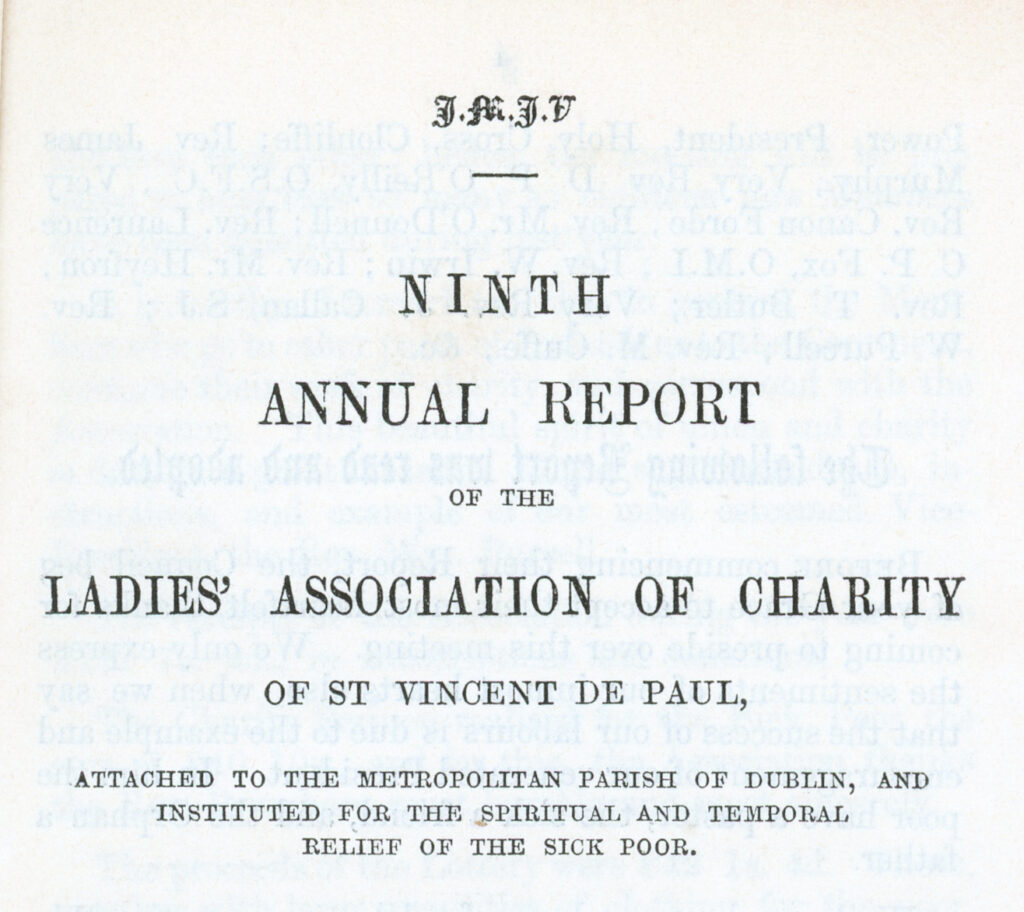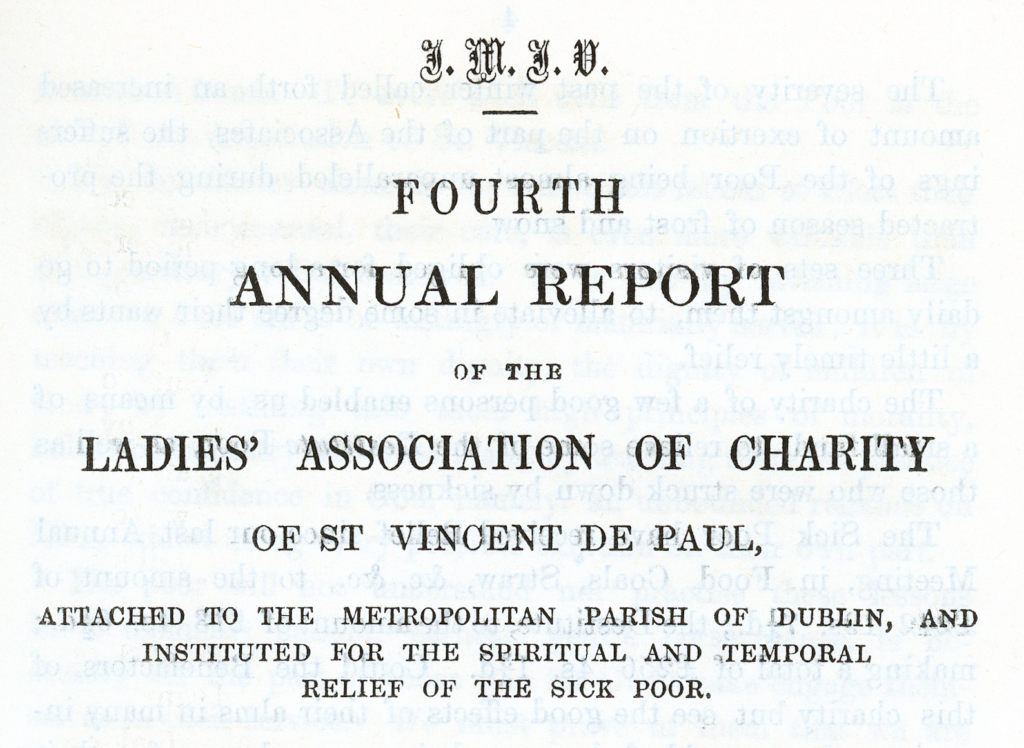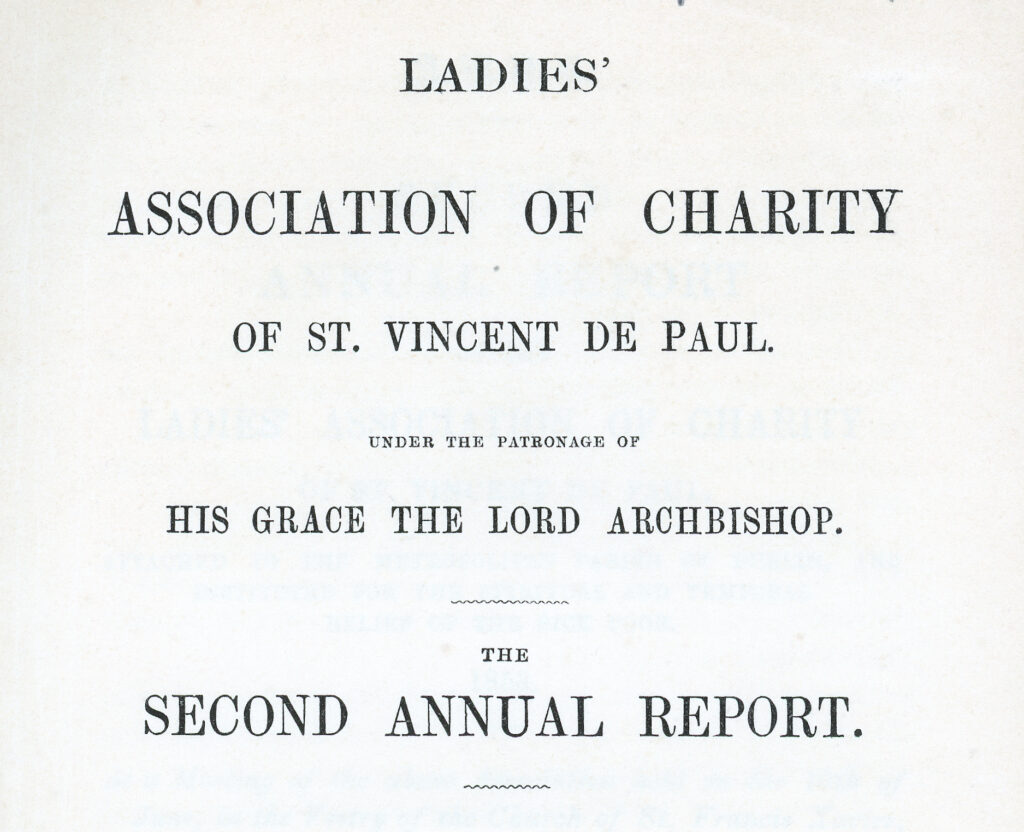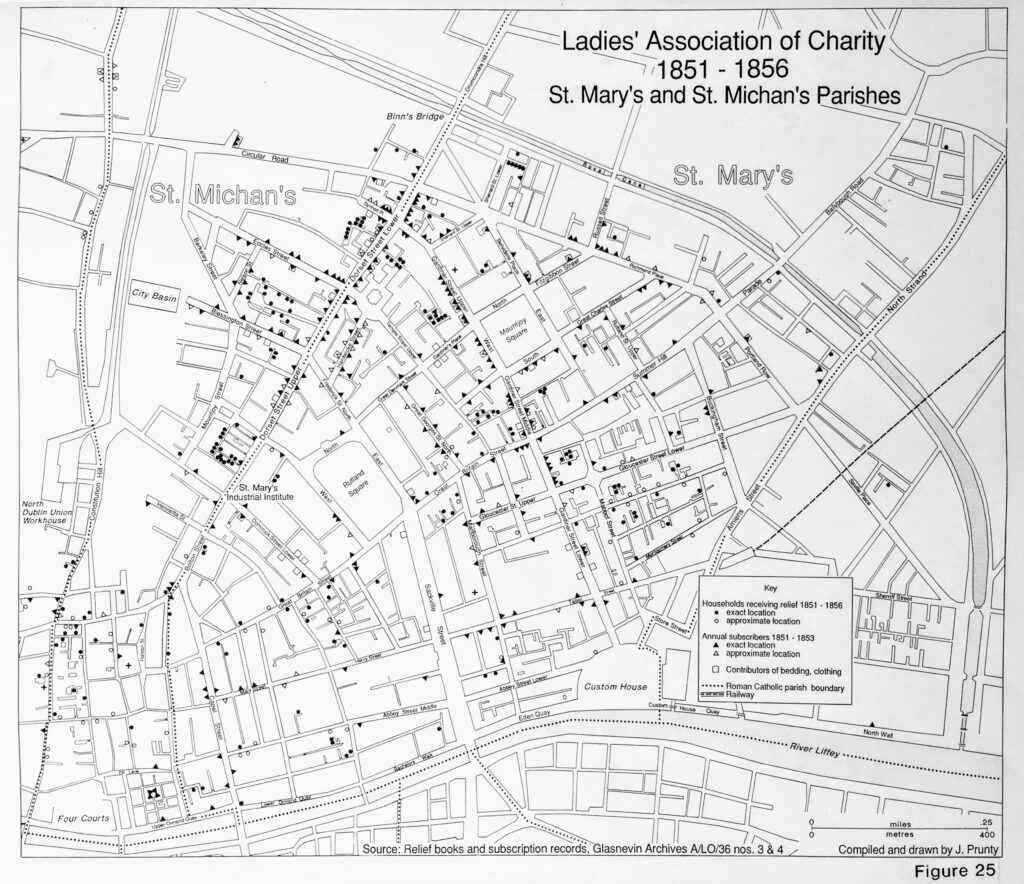About the Collection
This digital collection consists of a series of eleven Annual Reports of the Ladies’ Association of Charity of St. Vincent de Paul attached to the Metropolitan Parish of Dublin and instituted for the Spiritual and Temporal Relief of the Sick Poor. Published from 1852-1862, the reports describe the association’s mission, organisation, finances, events, challenges, and triumphs. According to Jacinta Prunty (1999, 56-57), Margaret Aylward is considered to be the principal author of these reports.
The reports are valuable little-known primary sources for the study of charity networks, poor relief, childcare, and education in nineteenth-century Ireland. The political and religious contexts within which they were written, including opposition to well-funded English evangelical missions in converting the Irish Catholic poor, all of which make parts of these reports difficult to handle today. There is certainly very little ecumenism in evidence (Interview with Jacinta Prunty, 30 September 2020).
The reports provide an annual update of the Ladies’ Association of Charity mission, philosophy, and objectives; that being the Temporal and Spiritual Relief of the Sick Poor. They describe the association’s administration, governance, and management. A further undertaking by the Ladies’ Association, was an on-going examination as to the reasoning behind why a considerable number of impoverished Catholic children were attending Protestant schools.

‘It soon became our duty to examine into the cause of so great a number frequenting Protestant schools. Here our path was beset with difficulty.….To ascertain if the children were principally Catholic, as the poor people asserted, we sought, and often obtained, admittance into the Protestant schools, which cover, as the snares of the fowler, the face of the city. Alike in the streets and by-lanes, in respectable looking building, bearing their date of erection in legible characters, and in back rooms and decaying houses is the work of proselytism stealthily carried on’ (First Annual Report of the Ladies’ Association of Charity of St. Vincent de Paul, 1852).
The reports describe the association’s administration, governance, and management. They address on-the-ground statistics, including the number of visits to the Sick Poor; the number of persons who remained on the Sick Poor list; and the mortality rate. Several case studies or testimonies are provided in the reports, detailing the conditions of the Sick Poor. Other details documented are the prevalence of diseases such as cholera, scrofula, affections of the lungs, and influenza. Scattered throughout the reports is an account of post-famine and inclement weather conditions and how this affected the Ladies’ Association of Charity and the inner-city poor.

‘But, how much of human suffering is prevented, how much of human woe is alleviated by the visits and the attentions paid to the poor! Sometimes the poor drunkard listens to the gentle rebuke and kind remonstrance of the Lady of Charity. Sometimes differences are settled, and neighbours are reconciled, and blessed peace that had departed, returns with the visit of the Lady of Charity. But, the generous natures, the keen perception, the sympathetic heart of our Irish poor, are always alive to the kindness done them. Hence, when they see our Ladies visiting them, instructing them, prayer with them, feeling for them, they become relieved indeed, a light breaks in upon their souls, joy beams in their countenances, and they forget for a time their miseries’ (Ninth Annual Report of the Ladies’ Association of Charity of St. Vincent de Paul, 1860).
Financial accounts were documented annually, detailing donations, subscriptions, and expenditures. The reports note the support and activities of guilds such as St. Patrick’s, St. Columbkille’s and St. Kevin’s Guild. A list of benefactors is listed in each report. Besides monetary contributions, donations often included items such as clothing, milk, and coal. To supplement a shortfall in fundraising and in anticipation of the same, they organised activities such as raffles, charity sermons, and a lottery. Aylward also instituted an anti-proselytising fund.

‘Not by money alone do the Association labour to effect their object: their counsel, their care, is even more valuable than the pecuniary relief bestowed. It is not by lavishing large alms to poor are to be lastingly, or materially served; it is by teaching them their own dignity, the dignity of children of God; by instilling into them high principles of morality, habits of industry and order, and by teaching them the practice of thought confidence of God, namely, an unbounded reliance on Him, whilst using every possible exertion on their own part’ (Fourth Annual Report of the Ladies’ Association of Charity of St. Vincent de Paul, 1855).
From 1853, several reports detail the inception and development of St. Mary’s Industrial Institute, albeit short-lived. Here, Aylward promoted employment for poor females through sewing and needlework. In 1857, St. Brigid’s Orphanage was introduced as ‘an accessory work’ of the Ladies, and a resolution was then passed requesting the establishment of a large orphanage. Aylward’s vision of a boarding-out system for St. Brigid’s Orphanage is encapsulated in the reports. Here, orphans were fostered by nurses (foster parents) living in the Irish countryside. The Annual Reports of St. Brigid’s Orphanage are included in the reports of the Ladies’ Association of Charity up until 1860. A full description of each report is available in the Annual Reports of St. Brigid’s Orphanage.

‘there is to be found a recompense for this truly consolatory duty. To be the means, no matter how humble, or how unworthy, of bringing to these poor sufferers, comfort, consolation, and relief; to bind up the broken heart, to raise the drooping spirit, to pour the balm of consolation, of comfort, and of hope, into the minds and hearts of the destitute and the afflicted-all this brings peace, and joy, and comfort, and happiness, to the hearts of the persons engaged in so blessed a service’ (Second Annual Report of the Ladies’ Association of Charity of St. Vincent de Paul, 1853).
References
Prunty, Jacinta (1999) Margaret Aylward: Lady of Charity, Sister of Faith 1810-1889, Four Courts Press, Dublin.
Collection Description
La Pina, Helena (2020) ‘Annual Reports of the Ladies’ Association of Charity of St. Vincent de Paul (1852-1862): About the Collection’, Holy Faith Digital Archive, available:http://hfsdigitalarchive.org/about-the-collections/lac-annual-reports/.
Browse the Collection >>

The map was compiled and drawn by Dr Jacinta Prunty, and may be used with the following citation:
Prunty, Jacinta, ‘Ladies’ Association of Charity, 1851-1856′. Map compiled from releief books and subscription records, A/LO/36, nos 3 & 4, available: Holy Faith Sisters Digital Archive, http://hfsdigitalarchive.org/about-the-collections/lac-annual-reports/
